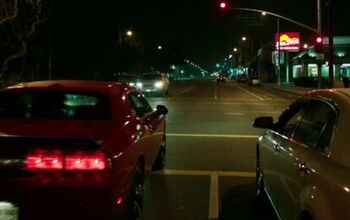TTAC At The Movies: "Senna"

Welcome to an unauthorized diversion from our core purpose called another episode of TTAC At The Movies. I’m your host, Jack Baruth, and this time we will be looking at a movie that is unlikely to find too much American viewership. (This is the second such review on TTAC; the first is here. Still, we are the site which had three people review the Camry.) Those who do watch it, however, are likely to be very passionate about the subject.
Quoth the Wiki:
In 2009, a poll of 217 current and former Formula One drivers conducted by the British magazine Autosport named [Aryton] Senna as the greatest Formula One driver.[2][6] He was recognised for his qualifying speed over one lap and from 1989 until 2006 held the record for most pole positions. He was especially quick in wet conditions, as shown by his performances in the 1984 Monaco Grand Prix, the 1985 Portuguese Grand Prix, and the 1993 European Grand Prix. He also holds the record for most victories at the prestigious Monaco Grand Prix – six – and is the third most successful driver of all time in terms of race wins.
As with Kurt Cobain, Jimi Hendrix, and a host of other notables, Senna’s already lustrous reputation was burnished by death in his prime; unlike the champions who succeeded him, most notably Villeneuve and Schumacher, nobody ever had to watch Senna plod through depressing end-of-career, back-of-the-pack seasons. (Of course, one might want to ask precious little Lewis Hamilton whether Herr Schumacher still has any fight left in him.) The documentary Senna is intended to be watchable by both F1 “anoraks” and people who are utterly ignorant of the sport. When Vodka McBigbra and I showed up to watch it on Friday night, therefore, we had a representative of each type.
Formula One fans will want to watch the movie. It’s powerful, it’s well-edited, and it is utterly compelling. The best possible use is made of the footage available, particularly some stunning low-angle, on-board Monaco films which are far more impressive and engaging than the modern top-of-rollbar shots in 1920pqrs or whatever the current format is. One of my F1-fan pals noted “Anybody watching the movie would think that the F1 season had three races: Brazil, Monaco, and Japan,” and that’s at least partially true, since those races are the most-discussed.
The Prost/Senna rivalry is emphasized as much as humanly possible, and just when you, the viewer, are ready to hop out of your chair, catch a flight to Paris, and punch the dispassionate, manipulative Frenchman in his distended beak, the film turns a corner and emphasizes Prost’s service to Senna’s legacy after the 1994 accident. Jean-Marie Balestre, on the other hand, receives no such redemption.
Prior to watching the movie, my companion had only heard the word “Senna” from me, and in some highly questionable contexts: “I’m the Senna of NASA Performance Touring,” “that move that got me disqualified was just what Senna would do,” “sure, I threw a temper tantrum in the meeting, but Senna did that,” and so on. By the end of the movie, she fully understood what the man himself had endured and achieved; more importantly for those of you who may have to drag spouses to the movie, she was enthralled. The only scenes which dragged for her were the on-board camera shots showing how the gap at a certain chicane had narrowed and that kind of thing. “Like watching football when you don’t understand football.” Fair enough. She did, however, get the main points: great wet-weather driver, very passionate, hated Alain Prost, three-time world champion, and currently dead.
Death, by the way, is perhaps the one aspect of the movie which is not perfectly handled. Too much of the film is devoted to segments of Senna interviews where the man discusses his fear of death, his fear of accidents, the likelihood of death, and so on. The first three or four times this happens in the movie, it’s poignant and touching. The seventh or eighth, one is tempted to say, Yes. Enough. We get it. He knew he could die, but he thought he had a long life ahead. Yes. We understand.
The movie is also shot with a uniquely South American sensibility. As a cyclist who trained South American men for a decade, I learned quickly that they don’t act like USian men. They cry in public, they kiss their mothers and sisters, they openly discuss their emotions, they have no taste for the laconic quip in the face of danger. A Brazilian or Bolivian man would think nothing of crying because he lost a race. When Senna perorates at some length about how he is afraid to die, it doesn’t match up very well with my idea of the stoic racing driver, chomping a cigar before cheating death and saying things like, “I suppose a chap could check right out of the motel in that turn, were he unlucky enough to bollocks it up.”
The movie would probably also benefit from an English-language narrator instead of endless subtitles. Moviegoers who don’t like to read the screen, or who cannot read small subtitles on a shifting background, will not be pleased. No attempt is made to disguise the foreign nature of the film; although English is the working language of Formula One, it is not the working language of Senna.
These relatively small gripes aside, we are talking about a film which simply vaults over most of the racing-related cinema of the past fifty years. The last major open-wheel-centric movie to be shown in American theaters was, if memory does not fail me, Sylvester Stallone’s Driven. The difference between the two is adequately explained like so: Senna shows a long shot of a broken, despondent Frank Williams looking into the sky for a God who may or may not exist, while Driven has Burt Reynolds in a wheelchair and CART racers who take impromptu spins on public roads without their helmets.
It’s worth watching, and although doing so will take some effort for many Americans, that effort will be rewarded.

More by Jack Baruth
Latest Car Reviews
Read moreLatest Product Reviews
Read moreRecent Comments
- Jrhurren Unions and ownership need to work towards the common good together. Shawn Fain is a clown who would love to drive the companies out of business (or offshored) just to claim victory.
- Redapple2 Tadge will be replaced with a girl. Even thought -today- only 13% of engineer -newly granted BS are female. So, a Tadge level job takes ~~ 25 yrs of experience, I d look at % in 2000. I d bet it was lower. Not higher. 10%. (You cannot believe what % of top jobs at gm are women. @ 10%. Jeez.)
- Redapple2 .....styling has moved into [s]exotic car territory[/s] tortured over done origami land. There; I fixed it. C 7 is best looking.
- TheEndlessEnigma Of course they should unionize. US based automotive production component production and auto assembly plants with unionized memberships produce the highest quality products in the automotive sector. Just look at the high quality products produced by GM, Ford and Chrysler!
- Redapple2 Got cha. No big.

































Comments
Join the conversation
I just saw the theatrical release tonight at my local repertory theatre. The movie is really good. Tears ran down my cheeks at the end of the movie - and I noticed the same with a retired guy I chatted with in the next seat. My wife even liked it too. I've ordered the uncut bluray from amazon to get the full deal. As they say in the Michelin Guide: worth the detour.
Heads up: Senna is streaming on Netflix now.